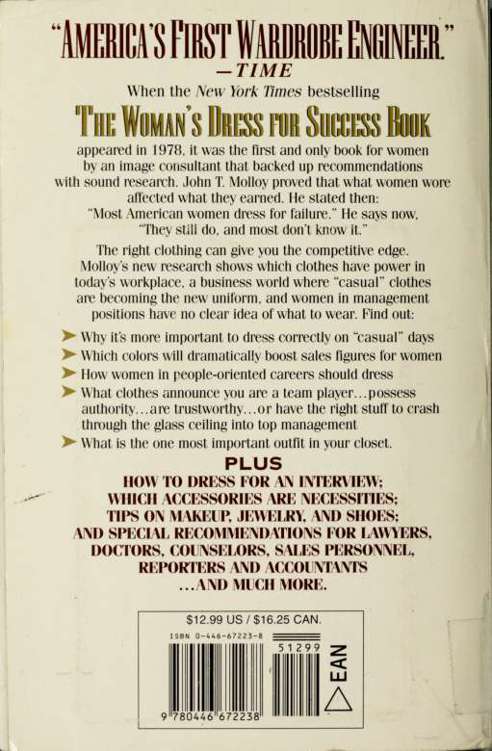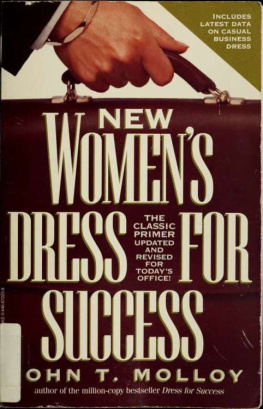Molloy - New women’s dress for success
Here you can read online Molloy - New women’s dress for success full text of the book (entire story) in english for free. Download pdf and epub, get meaning, cover and reviews about this ebook. year: 1996, publisher: New York : Warner Books, genre: Detective and thriller. Description of the work, (preface) as well as reviews are available. Best literature library LitArk.com created for fans of good reading and offers a wide selection of genres:
Romance novel
Science fiction
Adventure
Detective
Science
History
Home and family
Prose
Art
Politics
Computer
Non-fiction
Religion
Business
Children
Humor
Choose a favorite category and find really read worthwhile books. Enjoy immersion in the world of imagination, feel the emotions of the characters or learn something new for yourself, make an fascinating discovery.
- Book:New women’s dress for success
- Author:
- Publisher:New York : Warner Books
- Genre:
- Year:1996
- Rating:3 / 5
- Favourites:Add to favourites
- Your mark:
- 60
- 1
- 2
- 3
- 4
- 5
New women’s dress for success: summary, description and annotation
We offer to read an annotation, description, summary or preface (depends on what the author of the book "New women’s dress for success" wrote himself). If you haven't found the necessary information about the book — write in the comments, we will try to find it.
The classic primer updated and revised for todays office!--Cover
Molloy: author's other books
Who wrote New women’s dress for success? Find out the surname, the name of the author of the book and a list of all author's works by series.
New women’s dress for success — read online for free the complete book (whole text) full work
Below is the text of the book, divided by pages. System saving the place of the last page read, allows you to conveniently read the book "New women’s dress for success" online for free, without having to search again every time where you left off. Put a bookmark, and you can go to the page where you finished reading at any time.
Font size:
Interval:
Bookmark:
This book made available by the Internet Archive.







This book, along with everything I do, is dedicated to Maureen and Rob
I would like to thank Valerie Mars, whose sharp pencil and sharper mind worked with me through the book's many changes.
\
Foreword
o>
/\ woman's success does not depend entirely or even primarily on how she dresses, but dress is an important factor in most women's careers. Research shows that when a woman dresses for success, it does not guarantee success, but if she dresses poorly or inappropriately, it almost ensures failure. Most women know men who dress horribly and are very successful. Dressing poorly does not destroy a man's career the way it does a woman's. If a man is really good at what he does, he is often referred to as "a diamond in the rough" and can move up in spite of a poor image. However, if a woman dresses inappropriately, she will be eliminated from consideration for management by most men and women managers. This is obviously a double standard and certainly not fair. However, it is the way the real world operates, and you have to deal with it.
Several months before this book was published I was challenged to prove that "dressing for success" remained a valid concept. As a result, I spent three weeks on the telephone persuading managers in 142 offices to take pictures of their people for one week. Some took the pictures with their employees'
Foreword
knowledge and cooperation, some took them secredy. We asked them to personally divide their employees into three categories: those who dressed for success, those who dressed suitably, and those who dressed either poorly or inappropriately. When they arrived at our office, we divided the people into similar groups based on my research. Surprisingly, even though we purposely chose thirty-four bosses who said they did not believe dressing for success was a factor in their offices, most of them placed people in the same categories we did. We then asked these same managers to place the people into three groups: those who were successful or likely to be successful, those who still had a chance at succeeding, and those who would never succeed.
Those who were thought to be good dressers by their bosses were one and a half times more likely to be placed in the top group than average dressers and almost four times more likely than poor dressers. While the numbers were not identical and our survey techniques varied, there was no substantial difference from a similar survey I conducted almost thirty years ago. It seems the more things change, the more they remain the same. Today most businesswomen still dress for failure.
When we analyzed the data we found that dress affected women, short men, and minorities more than average-height and tall white males. There were similar differences among women. It was more important for short, heavy, voluptuous, very beautiful, and older women to dress well than it was for average women. We further discovered that dress also had a greater impact on managers and professionals than on others. In fact, dressing well is a hallmark of most women managers. Women who dress poorly or inappropriately do not seem to get into management. After talking to over two thousand businesswomen in client corporations in the last three years, I estimate
Xll
Foreword
that within the United States several hundred thousand are quahfied in every way for management but have no chance because they do not look the part. Finally, dressing professionally is most important for women who have to deal effectively with relative strangers on a regular basis. However, dressing effectively is important not only to those who must deal with strangers. Dress affects, in a meaningful way, the careers of most women, including many who think that while dressing for success may work for others, it would not work for them. A prime example of this were women scientists who worked in seven different laboratories. These women never saw or were seen by anyone but their co-workers and bosses, and some saw them only occasionally. They and their supervisors believed that all that counted was the quality of their work. Yet even in these settings, those who dressed like professionals, not backroom researchers, were twice as likely as their equally talented sisters to move into supervisory positions.
The finding that surprised the researchers was that dress counted most for those who work in casual environments. When I surveyed women managers and professionals, most of them were aware of the impact of casual dress on their ability to perform and put more effort into choosing their outfits for casual Fridays than they did for the rest of the week.
Because it was critical to the book, I ran a second study to verify the findings of the first. I located twenty-two large and midsize companies where the reviewer was required to comment on the employees' dress as a part of their annual review and talked them into participating. They became involved because they wanted to know the effect of their employees' dress on the workplace. After they received the results, seven told me that they were considering changing their dress codes.
Since each employee's perfomance was reviewed annually
Xlll
Foreword
or semiannually, the performance reviews gave us a view of how their dress affected their careers not only at that moment, but over a period of time. Since the purpose of the reviews is to make employees aware of their shortcomings and to motivate them to improve, often when an employee's dress was criticized, the employee changed. We ran across 102 women who were commended in the next review for their improved dress. These improvements had an interesting effect on how the reviewer, who was often the woman's immediate supervisor, saw her. In about half the cases, within two years the reviewer started looking at the woman in a more favorable light. Five to seven years later most of the remaining supervisors started seeing the women as more able, but some never changed their opinion. Apparently, when some people form an impression, they never change it. However, improving was not a waste of time. When the employees with new improved images changed jobs or bosses, their new bosses saw them, sometimes for the first time, in a positive light. This is exactly the same results we had when we trained people to be more popular. When they interacted with new people, most received the preferential treatment that all popular people receive, but when they dealt with people who knew them in the past only half responded positively to their sending popular signals.
Obviously that is bad news for people who dress poorly, but luckily it is not the whole story. A woman who starts to dress for success immediately has a measurable statistical advantage over her competitors with respect to promotions, especially when dealing with relative strangers and even when dealing with people who have known her for years. This book, which will take at most a few hours to read, can give you that advantage.
Next pageFont size:
Interval:
Bookmark:
Similar books «New women’s dress for success»
Look at similar books to New women’s dress for success. We have selected literature similar in name and meaning in the hope of providing readers with more options to find new, interesting, not yet read works.
Discussion, reviews of the book New women’s dress for success and just readers' own opinions. Leave your comments, write what you think about the work, its meaning or the main characters. Specify what exactly you liked and what you didn't like, and why you think so.













